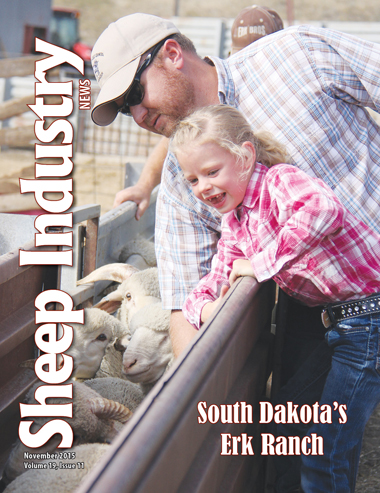To View the November 2015 Digital Issue — Click Here

H-2A Rule Retains Procedures that Sustained Program for 50 Years
Burton Pfliger, ASI President
I am pleased to share that the U.S. Department of Labor issued the H-2A sheepherder program final rule and it has major modifications from the April proposal that would have wiped out much of our industry.
The final rule retains nearly all of the special procedures that have made the sheepherder program work for the past 50 years, such as mobile housing, hourly exemption and annual visas. We had to convince labor that their April proposal to triple wages would be unaffordable to most ranches. This was accomplished by a coalition of the national sheep organizations agreeing on a wage methodology that had a chance of adoption by the department, and that meant a change and an increase would be necessary.
The coalition provided the industry a chance to speak in one unified voice, which was critical in this effort. If we pushed three different recommendations, the federal officials likely would have stayed with their proposal and we would be seeing ranches exiting the business.
In addition to the importance of the coalition, each of you that provided comments to the Federal Register comment period carried the day. More than 500 ranchers, affiliated business, local and state governments were very impactful on the labor department and we owe each commenting party a note of thanks for the time and energy in April and May to provide input. I encourage readers to visit the ASI Legislative Action Center at SheepUSA.org and read the comments and the summary of the final rule. Dozens and dozens of people in our business are quoted by the department in explaining how the program works and why the proposed changes didn’t.
ASI provided an early message focused on the two most important issues with the proposal last spring and used 20,000 mailings and email contacts to get the word out for action. We appreciate the folks that commented and kept Congress informed on the rule. The dozens of members of Congress that weighed in on our behalf are listed on our website as well, so ensure you share your appreciate for their help. Finally, we provided our analysis on the rule with the U.S. Department of Agriculture and appreciate our agriculture leaders sharing the sheep information with their sister agencies as described in the final rule.
Trans Pacific Partnership
From the outset several years ago, we didn’t view the TPP agreement as benefitting American sheep production much since the countries involved were either huge sheep producers (Australia and New Zealand) or already had a trade agreement with the United States (Mexico and Canada). The potential reduction in tariffs on American lamb to Japan would be helpful once the USDA secures access for our lamb again to that market. Japan was lucrative for us until cattle BSE shut down trade years ago.
On the wool side, we anticipate the agreement is done correctly regarding the rule of origin on wool yarn, particularly in reference to Vietnam. Some countries, such as Australia, were pushing a rule that would provide China benefits even though they are not a party to the agreement.
It is interesting to view how American interests that have protections from imports dealt with the agreement given the large export presence of Australia and New Zealand. Beef and dairy appear to go opposite ways with dairy largely holding on to protections from imports, while beef would phase out their tariff rate quotas with participating countries. The U.S. never included lamb in the Meat Import Law that was legislated in the 1960s, 70s and 80s, so our industry didn’t have the opportunity in this agreement to keep a protection. Not that the National Wool Growers didn’t work the issue hard every time, however, they were not successful. After the 1993 round of General Agreement on Tariffs and Trade that set up the World Trade Organization, any new import protection schemes would have been ruled illegal.
Supporting the Sheep Industry
I read a state association newsletter last month that discussed two of the new programs conducted this fall on sheep and wool production, and was very complimentary of the attendance and subjects addressed. I recognized both programs described and was pleased the article relayed the efforts very encouragingly as funded by the Let’s Grow initiative. The article did not mention ASI or the ASI funding that sponsored the programs, however.
I raise this as a reminder that we need to promote our associations and encourage all sheep producers to participate. Some sheep producers might not be interested in legislative or regulatory issues, but may well join our associations for the ASI Let’s Grow program or perhaps the Sheep Industry Development handbook or maybe for the monthly Sheep Industry News, published by ASI. I encourage you to share your monthly magazine with sheep producers that have not yet joined your state association. It’s always a good idea to share the positive programs that our state and national associations provide for the farm and ranch families that produce sheep.


